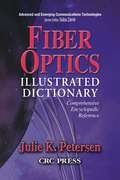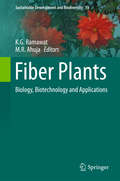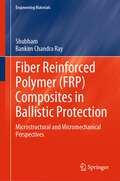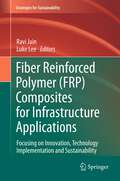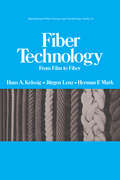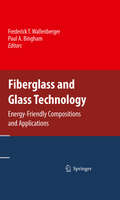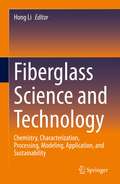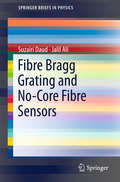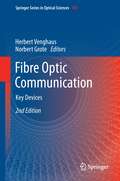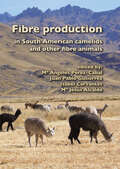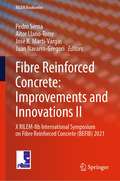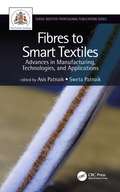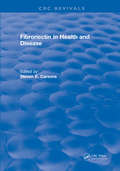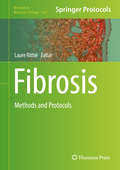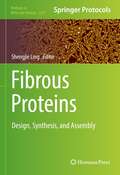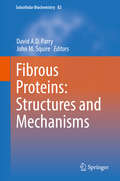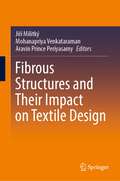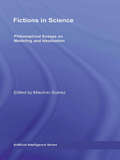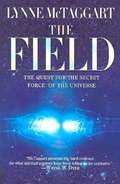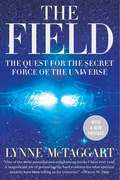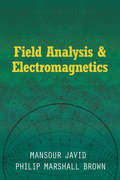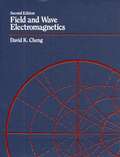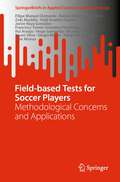- Table View
- List View
Fiber Optics Illustrated Dictionary (Advanced & Emerging Communications Technologies)
by J.K. PetersenWithin a few short years, fiber optics has skyrocketed from an interesting laboratory experiment to a billion-dollar industry. But with such meteoric growth and recent, exciting advances, even references published less than five years ago are already out of date.The Fiber Optics Illustrated Dictionary fills a gap in the literature by providing instructors, hobbyists, and top-level engineers with an accessible, current reference. From the author of the best-selling Telecommunications Illustrated Dictionary, this comprehensive reference includes fundamental physics, basic technical information for fiber splicing, installation, maintenance, and repair, and follow-up information for communications and other professionals using fiber optic components. Well-balanced, well-researched, and extensively cross-referenced, it also includes hundreds of photographs, charts, and diagrams that clarify the more complex ideas and put simpler ideas into their applications context.Fiber optics is a vibrant field, not just in terms of its growth and increasing sophistication, but also in terms of the people, places, and details that make up this challenging and rewarding industry. In addition to furnishing an authoritative, up-to-date resource for relevant industry definitions, this dictionary introduces many exciting recent applications as well as hinting at emerging future technologies.
Fiber Plants
by K. G. Ramawat M. R. AhujaThis book assesses the potential effects of biotechnological approaches, particularly genetic modification, on the present state of fiber crop cultivation and sustainable production. Leading international researchers discuss and explain how biotechnology can affect and solve problems in connection with fiber crops. The topics covered include biology, biotechnology, genomics and applications of fiber crops like cotton, flax, jute and bamboo. Providing complete, comprehensive and broad subject-based reviews, the book offers a valuable resource for students, teachers, and researchers including agriculturists, biotechnologists and botanists, as well as industrialists and government agencies involved in the planning of fiber crop cultivation.
Fiber Reinforced Polymer: Microstructural and Micromechanical Perspectives (Engineering Materials)
by Shubham Bankim Chandra RayThis book highlights the pulchritudinous features of FRP composites emphasizing failure criteria referring to microstructural as well as micromechanical aspects. The potential and promises of this class of material as being explored for supercritical applications necessitate the analysis and assessment of FRPs with a spectrum of low to high strain rates. Additionally, constitutive modeling and shock properties of polymeric composites along with the data processing techniques and relevant theories for different characterization methods are conversed. The findings of previous studies available on mechanical characteristics of polymer composites under quasi-static and high-strain-rate circumstances are also discussed. The dearth of open literature and limited information culminate the need for this book which may eventually bridge the existing gap.
Fiber Reinforced Polymer (FRP) Composites for Infrastructure Applications
by Ravi Jain Luke LeeThis book examines current issues of fiber reinforced polymer (FRP) composites in civil infrastructure. The contents of this book are divided into two parts. The first part engages topics related to durability and service life of FRP composites and how they contribute to sustainability. The second part highlights implementation and applications of the FRP composites with an emphasis on bridge structures. An introductory chapter provides an overview of FRP composites and its role in a sustainable built environment highlighting the issues of durability and service life followed by a current review of sustainability in infrastructure design.
Fiber Technology: From Film to Fiber (International Fiber Science And Technology Ser. #4)
by Hans A. KrassigThis book is intended to fiber technologists, textile dealers, and textile salesmen a practical guideline to become acquainted with and to deepen their knowledge of the processes for the manufacture of film tapes, split-film yarns, and fibrillated film fibers.
Fiberglass and Glass Technology
by Frederick T. Wallenberger Paul A. BinghamFiberglass and Glass Technology: Energy-Friendly Compositions and Applications provides a detailed overview of fiber, float and container glass technology with special emphasis on energy- and environmentally-friendly compositions, applications and manufacturing practices which have recently become available and continue to emerge. Energy-friendly compositions are variants of incumbent fiberglass and glass compositions that are obtained by the reformulation of incumbent compositions to reduce the viscosity and thereby the energy demand. Environmentally-friendly compositions are variants of incumbent fiber, float and container glass compositions that are obtained by the reformulation of incumbent compositions to reduce environmentally harmful emissions from their melts. Energy- and environmentally-friendly compositions are expected to become a key factor in the future for the fiberglass and glass industries. This book consists of two complementary sections: continuous glass fiber technology and soda-lime-silica glass technology. Important topics covered include: o Commercial and experimental compositions and products o Design of energy- and environmentally-friendly compositions o Emerging glass melting technologies including plasma melting o Fiberglass composite design and engineering o Emerging fiberglass applications and markets Fiberglass and Glass Technology: Energy-Friendly Compositions and Applications is written for researchers and engineers seeking a modern understanding of glass technology and the development of future products that are more energy- and environmentally-friendly than current products.
Fiberglass Science and Technology: Chemistry, Characterization, Processing, Modeling, Application, and Sustainability
by Hong LiThis book highlights recent developments in fiberglass research and technology development, including high-performance fiberglass chemistry; in-depth glass network structure information derived from the-state-of-the-art spectroscopic measurements, molecular dynamics simulations, and their correlations with properties; fiber surface chemistry in relation to sizing chemistry - a critical part of composite performance; fiber process stability; fundamental understanding of the batch-to-melt conversion processes and melt flow simulations; and environmental concerns such as energy efficiency and emission of volatile species, which are key to environmentally-friendly product manufacturing. The book aims to guide fiberglass researchers and manufacturers towards better awareness and, perhaps, provides potential options for global ecosystem management. More than 500 current references are included, which will enable researchers from fiber glass industry and research institution access to the most recent progress in fiberglass science and technology. Advances scientific understanding of fiberglass-forming processes, rising in popularity as a building material throughout the world;Describes the current advances in the structure and formation of fiber glass, beginning with chemistry, a wide range of characterizations, and processes, through to applications;Contains information on environmental aspects of fiberglass production, addressing energy consumption and emission.
Fibre Bragg Grating and No-Core Fibre Sensors (SpringerBriefs in Physics)
by Suzairi Daud Jalil AliThis book focuses on the development and set-up of fibre Bragg grating (FBG) and no-core fibre (NCF) sensors. It discusses the properties of the sensors and modelling of the resulting devices, which include electronic, optoelectronic, photovoltaic, and spintronic devices. In addition to providing detailed explanations of the properties of FBG and NCF sensors, it features a wealth of instructive illustrations and tables, helping to visualize the respective devices’ functions.
Fibre Optic Communication: Key Devices (Springer Series in Optical Sciences #161)
by Norbert Grote Herbert VenghausThe book gives an in-depth description of key devices of current and next generation fibre optic communication networks. Devices treated include semiconductor lasers, optical amplifiers, modulators, wavelength filters and other passives, detectors, all-optical switches, but relevant properties of optical fibres and network aspects are included as well. The presentations include the physical principles underlying the various devices, technologies used for their realization, typical performance characteristics and limitations, but development trends towards more advanced components are also illustrated. This new edition of a successful book was expanded and updated extensively. The new edition covers among others lasers for optical communication, optical switches, hybrid integration, monolithic integration and silicon photonics. The main focus is on Indium phosphide-based structures but silicon photonics is included as well. The book covers relevant principles, state-of-the-art implementations, status of current research as well as expected future components.
Fibre production in South American camelids and other fibre animals
by Maria Jesús Alcalde Maria Ángeles Pérez-Cabal Isabel Cervantes Juan Pablo GutiérrezThis book, 'Fibre production in South American camelids and other fibre animals', covers the latest advances in the main fields of animals producing fibre. It deals with a wide scope of fibre animals and a great variety of subjects and is supported by the Animal Fibre Working Group belonging to the European Association of Animal Production. The book can be considered a valuable attempt to prepare the fibre production sector for rapid changes and innovations arising within a globalised world. The focus lies on fibre animals such as alpacas, llamas, vicunas and guanacos, but recent research on sheep, goats and rabbits is also included. The most important themes addressed are meat and fibre production, breeding and genetics, nutrition, reproduction, management, and health. Finally, the book closes with specialised discussions on fibre production related topics, which for example provide a more in-depth look at common management denominators between South American camelids and other fibre animals. The book addresses scientists, professionals, technicians, farmers, specialised governmental policy makers and students all around the world who are involved in fibre animal production (such as sheep, camelids, goats, or rabbits). This book will present them with the most current findings in this area.
Fibre Reinforced Concrete: X RILEM-fib International Symposium on Fibre Reinforced Concrete (BEFIB) 2021 (RILEM Bookseries #36)
by Pedro Serna Aitor Llano-Torre José R. Martí-Vargas Juan Navarro-GregoriThis volume highlights the latest advances, innovations, and applications in the field of fibre-reinforced concrete (FRC), as presented by scientists and engineers at the RILEM-fib X International Symposium on Fibre Reinforced Concrete (BEFIB), held in Valencia, Spain, on September 20-22, 2021. It discusses a diverse range of topics concerning FRC: technological aspects, nanotechnologies related with FRC, mechanical properties, long-term properties, analytical and numerical models, structural design, codes and standards, quality control, case studies, Textile-Reinforced Concrete, Geopolymers and UHPFRC. After the symposium postponement in 2020, this new volume concludes the publication of the research works and knowledge of FRC in the frame of BEFIB from 2020 to 2021 with the successful celebration of the hybrid symposium BEFIB 2021. The contributions present traditional and new ideas that will open novel research directions and foster multidisciplinary collaboration between different specialists.
Fibres to Smart Textiles: Advances in Manufacturing, Technologies, and Applications (Textile Institute Professional Publications)
by Asis Patnaik Sweta PatnaikFibres to Smart Textiles: Advances in Manufacturing, Technologies, and Applications offers comprehensive coverage of the fundamentals and advances in the textile and clothing manufacturing sectors. It describes the basics of fibres, yarns, and fabrics and their end use in the latest developments and applications in the field and addresses environmental impacts from textile processes and how to minimize them. This book serves as a single comprehensive source discussing textile fibres, yarn formation, filament formation techniques, woven fabric formation, knitting technologies, nonwoven manufacturing technologies, braiding technologies, and dyeing, printing, and finishing processes. Testing of textile materials, environmental impacts of textile processes and use of CAD and CAM in designing textile products are also included. The book also discusses applications including textile composites and biocomposites, technical textiles, smart textiles, and nanotextiles. With chapters authored by textile experts, this practical book offers guidance to professionals in textile and clothing manufacturing and shows how to avoid potential pitfalls in product development.
Fibronectin in Health and Disease
by Steven E. CarsonsThis timely volume highlights current knowledge concerning the role of fibronectin in human biology and medicine. It is intended to stimulate further investigation in this area. Emphasized are the importance of fibronectin in the interaction between the cell and its environment; and the role of the fibronectin in the determination of cell behavior in normal physiologic processes, in malignant behavior of cells, and in inflammatory disease. This book is valuable to those in the biomedical community interested in fibronectin, the microenvironment and extracellular matrix. It is also important to those interested in the pathobiochemistry of malignant disease and inflammatory disorders.
Fibrosis: Methods and Protocols (Methods in Molecular Biology #1627)
by Laure RittiéThis volume describes state-of-the-art protocols that serve as “recipes” for scientists concentrating on fibrosis research. This book is divided into four sections. Part I focuses on animal models of fibrosis and covers topics such as mimicking fibrosis in the lungs, skin, liver and heart, and generating transgenic mouse models. Part II discusses cell culture systems, where the chapters explore cell types important for the development of fibrosis. Part III looks at the purification, quantification, and analysis of the ECM proteins, and Part IV describes computer-assisted methods such as quantifying fibrillar collagen alignment and exploring the nano-surface of collagen with atomic force microscopy (AFM). Written in the highly successful Methods in Molecular Biology series format, chapters include introductions to their respective topics, lists of the necessary materials and reagents, step-by-step, readily reproducible laboratory protocols, and tips on troubleshooting and avoiding known pitfalls. Cutting-edge and practical, Fibrosis: Methods and Protocols is a valuable resource aimed at outstanding quality and repeatability of research experiments in the fibrosis field.
Fibrous materials
by Krishan K. ChawlaThis new updated edition provides an unrivaled overview of fibrous materials, their processing, microstructure, properties, and applications. The entire range of fibrous materials is discussed in depth, from natural polymeric fibers such as silk and vegetable fibers, and synthetic polymeric fibers such as aramid and polyethylene, to metallic fibers including steel, tungsten, Nb-Ti, and Nb3Sn, ceramic fibers such as alumina and silicon carbide, and carbon and glass fibers. Fundamental concepts are explained clearly and concisely along with detail on applications in areas including medicine, aerospace, optical communications, and recycling. Significant recent advances are also covered, with new information on the electrospinning of fibers, carbon nanotubes, and photonic bandgap fibers, and detail on advances made in the production and control of microstructure in high stiffness and high strength fibers. Accessibly written and unrivaled in scope, this is an ideal resource for students and researchers in materials science, physics, chemistry, and engineering. The only comprehensive introduction to the topic. Fully updated with new information on electrospun fibers, carbon nanotubes, and photonic bandgap fibers. Covers a range of applications in areas including medicine, aerospace, optical communications, and recycling.
Fibrous Proteins: Design, Synthesis, and Assembly (Methods in Molecular Biology #2347)
by Shengjie LingThis detailed volume explores fibrous proteins widely present in different biological tissues or biological structural materials. The book begins by introducing the structure of representative fibrous proteins, including animal silks, collagen, elastin, resilin, and keratin, and it then continues by providing detailed experimental protocols for the synthesis, assembly, and characterization of natural, regenerated, and recombinant fibrous proteins. Written for the highly successful Methods in Molecular Biology series, chapters include introductions to their respective topics, lists of the necessary materials and reagents, step-by-step, readily reproducible laboratory protocols, and tips on troubleshooting and avoiding known pitfalls. Authoritative and practical, Fibrous Proteins: Design, Synthesis, and Assembly is an ideal guide for researchers aiming to master fibrous protein preparations with the aid of this broad and interdisciplinary perspective on understanding the structure-property-function relationships of natural and reconstituted fibrous proteins.
Fibrous Proteins: Structures and Mechanisms
by David A. D. Parry John M. SquireThis book provides the readers with an up-to-date review of the design, structure and function of a representative selection of fibrous proteins in both health and disease. The importance of the α-helical coiled coil, a conformational motif based on the heptad repeat in the amino acid sequence of all α-fibrous proteins (and parts of some globular proteins) is underlined by three Chapters devoted to its design, structure, function and topology. Specific proteins covered in the text and which depend on the coiled coil for their structure and function, include the intermediate filament proteins, tropomyosin, myosin, paramyosin, fibrin and members of the spectrin superfamily. Also described are fibrous proteins based on the β-pleated sheet and collagen conformations. Recombinant structural proteins, especially of silk and collagen, are discussed in the context of developing new biomaterials with varied applications. Established researchers and postgraduate students in the fields of protein chemistry, biochemistry and structural biophysics will find Fibrous Proteins: Structures and Mechanisms to be an invaluable collection of topical reviews that describe the basic advances made in the field of fibrous proteins over the past decade. This book, written by recognized authorities in the field, provides a clear account of the current status of fibrous protein research and, in addition, establishes the basis for deciding the most appropriate directions for future activity, including the applications of protein engineering and the commercial exploitation of new biomaterials.
Fibrous Structures and Their Impact on Textile Design
by Jiří Militký Mohanapriya Venkataraman Aravin Prince PeriyasamyBooks on Textiles tend to focus solely on aesthetic or technical points of view. Designers’ understanding of special technical aspects of textile structure or the ability of researchers to grasp the design aspects would result in quantum leaps in innovations and creativity in the Textile domain. This book presents a holistic view integrating the viewpoints of designers and researchers. It presents previously unexplored features or possibilities, mainly in the field of textile structure constructions and characteristics. The main aim is a unique proper blending of both the technical and aesthetic sides of textile. Without compromising on the technicalities, it simplifies complex concepts to elevate the understanding of fashion designers. On the other hand, it also provides a viewpoint on aesthetics. The chapters are designed to provide a good balance of content for both fashion designers and professionals. The initial chapter sets the foundation of understanding with a healthy discussion about the latest technical trends of textiles’ functionalities and their new applications. A dedicated chapter discusses the practical use of lighting effects of side-emitting optical fibers in conjunction with color effects for textile design purposes. Further chapters deal with smart textiles design in the context of sensation and perception, basic aspects of textiles structures necessary for their rational design, and color characteristics of materials useful for designers. The book includes a special chapter on analyzing the business landscape of textile design. Overall, this book is expected to cater to the needs and give special knowledge important for both textile specialists and fashion designers.
Fictions in Science: Philosophical Essays on Modeling and Idealization (Routledge Studies in the Philosophy of Science)
by Mauricio SuárezScience is popularly understood as being an ideal of impartial algorithmic objectivity that provides us with a realistic description of the world down to the last detail. The essays collected in this book—written by some of the leading experts in the field—challenge this popular image right at its heart, taking as their starting point that science trades not only in truth, but in fiction, too. With case studies that range from physics to economics and to biology, Fictions in Science reveals that fictions are as ubiquitous in scientific narratives and practice as they are in any other human endeavor, including literature and art. Of course scientific activity, most prominently in the formal sciences, employs logically precise algorithmic thinking. However, the key to the predictive and technological success of the empirical sciences might well lie elsewhere—perhaps even in scientists’ extraordinary creative imagination instead. As these essays demonstrate, within the bounds of what is empirically possible, a scientist’s capacity for invention and creative thinking matches that of any writer or artist.
The Field: The Quest for the Secret Force of the Universe
by Lynne MctaggartGreat book on new age metaphysics and the new science. McTaggart describes scientific discoveries that she believes point to a unifying concept of the universe, one that reconciles mind with matter, classic Newtonian science with quantum physics and, most importantly, science with religion. At issue is the zero point field, the so-called "dead space" of microscopic vibrations in outer space as well as within and between physical objects on earth. These fields, McTaggart asserts, are a "cobweb of energy exchange" that link everything in the universe; they control everything from cellular communication to the workings of the mind, and they could be harnessed for unlimited propulsion fuel, levitation, ESP, spiritual healing and more.
The Field
by Lynne MctaggartScience has recently begun to prove what ancient myth and religion have always espoused: There may be such a thing as a life force. Lynne McTaggart, indefatigable investigative journalist, reveals a radical new biological paradigm -- that on our most fundamental level, the human mind and body are not distinct and separate from their environment but a packet of pulsating power constantly interacting with this vast energy sea. The Fieldis a highly readable scientific detective story that offers a stunning picture of an interconnected universe and a new scientific theory that makes sense of supernatural phenomena. Original, well researched, and well documented by distinguished sources,The Fieldis a book of hope and inspiration for today's world.
Field Analysis and Electromagnetics (Dover Books on Physics)
by Mansour Javid Philip Marshall BrownIntended for advanced undergraduates and graduate students in electrical engineering and physics, this text presents a science-oriented, mathematically complete, and unified approach to the study of field theory and electromagnetics. To facilitate a detailed development of the theoretical material, the authors reject the traditional historical "case study" approach in favor of the theory's logical development, followed by examples that illuminate facets of the theory. The book may be divided into three parts: field analysis, basic electromagnetic theory, and applications. Basic laws and concepts — along with their implications — are thoroughly discussed before detailed mathematical analysis is undertaken. In addition to rigorous treatments of all relevant derivations and proofs, appropriate emphasis is placed upon the physical significance of mathematical operations.
Field and Laboratory Methods in Primatology
by Joanna M. Setchell Deborah J. CurtisBuilding on the success of the first edition and bringing together contributions from a range of experts in the field, the second edition of this guide to research on wild primates covers the latest advances in the field, including new information on field experiments and measuring behaviour. It provides essential information and advice on the technical and practical aspects of both field and laboratory methods, covering topics such as ethnoprimatology; remote sensing; GPS and radio-tracking; trapping and handling; dietary ecology; and non-invasive genetics and endocrinology. This integrated approach opens up new opportunities to study the behavioural ecology of some of the most endangered primates and to collect information on previously studied populations. Chapters include methodological techniques; instructions on collecting, processing and preserving samples/data for later analysis; ethical considerations; comparative costs; and further reading, making this an invaluable tool for postgraduate students and researchers in primatology, behavioural ecology and zoology.
Field and Wave Electromagnetics
by David ChengRespected for its accuracy, its smooth and logical flow of ideas, and its clear presentation, Field and Wave Electromagnetics has become an established textbook in the field of electromagnetics. <p><p>This book builds the electromagnetic model using an axiomatic approach in steps: first for static electric fields, then for static magnetic fields, and finally for time-varying fields leading to Maxwell’s equations. This approach results in an organized and systematic development of the subject matter. Applications of derived relations to fundamental phenomena and electromagnetic technologies are explained.
Field-based Tests for Soccer Players: Methodological Concerns and Applications (SpringerBriefs in Applied Sciences and Technology)
by Filipe Manuel Clemente Rafael Oliveira Rui Silva Zeki Akyildiz Halil Ibrahim Ceylan Javier Raya González Francisco Tomás Fernández Rui Araújo Hugo Sarmento Ricardo Lima Bruno Silva Sérgio Matos Yung-Sheng Chen José AfonsoThis book systematically summarizes the accuracy, precision, and repeatability levels of field-based tests applied in soccer. It considers such details as the effectiveness of tests for different age categories and sexes. In this book, the readers will be able to check all the field-based tests conceived for fitness assessment in soccer through a large systematic review made to the literature. In addition a brief characterization of each test and presentation of the concurrent validity and repeatability levels for each test will be provided. Finally, the book contains a general discussion of the implications of the tests for different methodological approaches to training. It will be use to sports scientists and practitioners.
